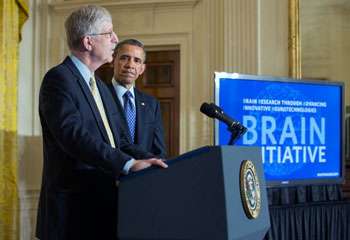Top Neurologists Urge Obama: Map the Other Brain!
 President Barack Obama’s famous BRAIN mapping initiative has been only 15%-of-a-brain initiative, said top NIH neuroscientist Douglas Fields recently, joined by a growing chorus of others.
President Barack Obama’s famous BRAIN mapping initiative has been only 15%-of-a-brain initiative, said top NIH neuroscientist Douglas Fields recently, joined by a growing chorus of others.
The reason: while 85% of the brain is made of glial cells, stunningly, no government-related BRAIN publications until recently mentioned the word. The main difference between Einstein and the rest of us—and between the rest of us and chimps—is more glia. Glia data has “dramatically” increased in the last two decades, says glia pioneer Maiken Nedergaard (who this year startled the field, making mice smarter with human glia).
Yet all BRAIN talk was about neurons, which make up only 15% of the organ, and which Fields decried in widely read September 4 Nature comment.
But this week, the BRAIN working group--which includes some of the US's best neurologists (if no glia experts)--published its interim report. The report, quickly approved by NIH (National Insitutes of Health) chief Francis Collins, mentioned the word "glia" for the first time--indeed, 22 times.
"It looks like the Nature comment had an impact," Fields now concludes.
Many neurologists rallied behind Fields in recent weeks. His Nature comment generated a "huge" Twitter response, along with 11,755 page views and 900 PDF downloads, far more than research papers garnish, Nature editors say.
“I completely support the main idea of Douglas Fields’ commentary,” said leading glia textbook authority Alexej Verkhratsky, reading Fields’ plea. “Understanding the brain by monitoring electrical connections between neurons is highly implausible. Evolution went through increases in numbers and specialization of cellular populations, with neurons perfecting fast impulse propagation at the expense of losing the ability to support themselves; to maintain the homeostasis on the nervous tissues; and to defend themselves. All these functions went to cells which we commonly know as neuroglia (or just “glia.”)”
“Our brain works on a range of time scales from milliseconds to seconds, to hours to days,” said Tufts Neuroscience Institute Director Phil Haydon, who wrote two of the glia field’s pioneering papers. “The millisecond timescale is dominated by the neuron. Glia are slower signaling cells capable of controlling processes on the extended time scale that may serve functions including consciousness, arousal, sleep, memory consolidation and mood. The BRAIN (Brain Research through Advancing Innovative Neurotechnologies) initiative will fall short of its bold and important goals if glia are not included as a primary focus…Field’s commentary highlights an important concern about the BRAIN initiative.”
“I am in complete agreement with Fields’ commentary,” said Eric Newman, Distinguished Professor of Neuroscience at the University of Minnesota, who also wrote a pioneering glia paper. “It is misguided to embark on an ambitious initiative to reveal the secrets of the brain, as the BRAIN initiative proposes to do, while ignoring the brain’s glial cells. It is well established that glial cells play essential roles in many aspects of brain function…and pathology.”
“Most people in the field now include glia in their thinking,” said University of Rochester neurologist Nedergaard, who wrote several pioneering glia papers. One found human glia are more than 20 times larger than rodent glia, far greater than the proportionate size of human and rodent neurons. (And our glia have grown 300% in number throughout evolution, compared to our neurons’ 25%.) Glia add such complexity to human thought that “ultimately, glia may be what distinguish us as human.”
She added: “Papers have increased dramatically since 1990 when the first paper came out –by Stephen Smith of Stanford University--showing glial cells chemically talk to each other.” Indeed, in 1989, the year before his paper, 576 papers mentioned the word “astrocyte,” a major glial cell. In 2012, there were 2,888 papers, a five-fold increase. “I am really surprised the Obama initiative doesn’t yet include the cells.”
Not all glial specialists expressed the same sentiments.
“No one agrees with Doug Fields more than I do that glia are critically important cells in the brain of huge significance for understanding both normal and abnormal brain function,” said another field pioneer, Stanford University neurologist Ben Barres. “But the main question is how $100 million dollars (annually--BRAIN's cost), which is not much, can be used in a strategic way... I know that the chairs of the BRAIN initiative, Rockefeller University’s Cori Bargmann and Stanford University’s Bill Newsome, are working very hard with their committee to develop a strategic plan right now. We are extremely fortunate that Bargmann and Newsome, senior leaders and outstanding neuroscientists, have stepped up to a leadership role for this initiative. If every neuroscientist demands their own subfield be given special attention, then the BRAIN initiative cannot possibly be successful. If instead the funds are strategically focused, this initiative has the potential to be spectacularly successful.”
Some neurologists argued in response that glia, with their 85% brain dominance, make up far more than a subfield. Regardless, co-chair Bargmann did note, shortly after reading the Nature piece, but before her working group's interim report was done, that there were few government writings on the matter, period--and that funding decisions for 2014 were far from over. “As far as I'm concerned, the more people get their ideas out there, including Douglas Fields, the better ideas will emerge," she said. "The NIH BRAIN Initiative working group is reading all of these we can get our hands on.”
Glial cells play critical roles in learning from cradle to grave, and neurodegenerative disorders from Alzheimers to ALS, says Haydon. “Much of the research of the past century interrogated the electrically active neurons because of the availability of electrical recording techniques.” But glial cells communicate primarily chemically. “Molecular genetics and imaging technologies now let us identify the many important roles of these non-neuronal cells, as is so eloquently discussed by Fields.”
Says Fields: “Things are coming together.”





